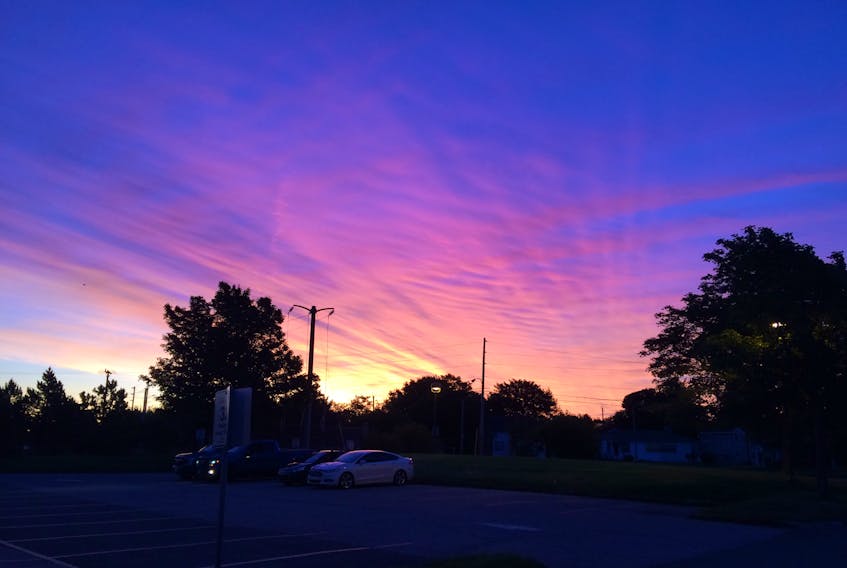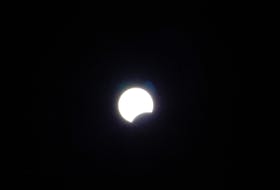Up with the birds, and the whole sky is rilled in pink, the clouds lit bright for what’s rarely more than a short 15-minute show.

Walking, I meet a few of the regulars, a woman who tilts to one side as she runs slowly, purposefully along the curb opposite. (I am always more impressed with the runners who aren’t the sleek, fast ones, the runners for whom the route is hard work always, and the fact that they keep trying.) I pass the construction workers marshalling together before taking the short walk to the never-finished Core Science Building. And the crows.
It looks like the same group pretty much every day, chuckling back and forth to each other like regulars at bingo, hop-hopping their way from tiny road kill — snails, slugs — to picking apart the fast-food road trash. One of the group with unusual white feathers that show at its wingtips.
I’ll admit that I talk to them calmly when I pass, mostly because I don’t want to disturb them into flying away. Crows regard you curiously, analytically, staring with almost unblinking black eyes. A few weeks ago, one of them got run over near the hospital; I saw it from a good distance away because it was windy, and even though the crow was dead, the aerodynamics of one of its wings kept it lifting and falling, lifting and falling.
The other crows gathered nearby, high up on the light standards, calling, calling. Like they were saying “Get up, Charlie, get up, stop fooling around.”
The total includes everyday birds you might not expect to lose, like the constant plain-jane grey juncos and the drifting flights of starlings.
I thought about that when reading the news that the number of birds in Canada and the U.S. has dropped by 29 per cent since 1970, a population drop that equals almost three billion birds.
Some populations are at more risk than others, though Ken Rosenberg, a scientist at the Cornell Lab of Ornithology and American Bird Conservancy and a lead author of the study, says there are “pervasive losses among common birds across all habitats.”
“This loss of abundance is so pervasive that it’s the old canary in a coal mine,” Rosenberg told the CBC. “It’s almost certainly an indicator of a degradation of overall environmental quality that’s ultimately going to affect people.”
Who amongst my regular companions are at risk? Is it the yellow warblers that flit through the weave of the alder branches, bright specks of olive and yellow that appear almost magically after small darts of flight, tilting their heads to one side to get a better look at you before getting back to the business at hand of plucking and eating insect larvae from the leaves and catkins?
The inquisitive chickadees, black-capped or boreal, that watch from the cover of the blue spruce, taking your measure and always finding you wanting? The cone-destroying crossbills?
It surely couldn’t be the blue jays, those saucy, cocky, almost tropical-looking rowdymen — like crows and seagulls, I imagine the blue jays would be around after almost any apocalypse, perching on the arched bones of our exposed ribcages as easily as they stand on any fencepost. But strangely, the total includes everyday birds you might not expect to lose, like the constant plain-jane grey juncos and the drifting flights of starlings.
And what about the less common birds, like Northern flickers, breaking the silence with their constantly offended and questioning “Skreeeee?”
The engine-thumping, swamp-lurking springtime snipe? The solitary deacon bitterns? The two-step-forward, one-step-back dance of the forest floor hunting fox sparrows?
The study says meadow birds are the most at risk because they’re losing their home range at the greatest pace to industrial agriculture and encroaching urbanization. But there are plenty of other stresses that affect nearly all species, from climate change to pesticides that are killing off the insects that birds depend on for food.
Some day, the science building will be finished, and the construction workers will move their morning coffee-and-cigarette klatches to a new venue, shifting their huge trucks to a new location.
The tilting lady may decide to stop running, or may change her route, and that’s OK, because almost certainly someone new will don (dawn?) the early morning sneakers.
But the crows?
I think I’d miss my companion crows the most.
Russell Wangersky’s column appears in SaltWire publications across Atlantic Canada. He can be reached at [email protected] — Twitter: @wangersky
MORE FROM RUSSELL WANGERSKY
• Abuse shouldn’t be part of the job
• Things found in walls









